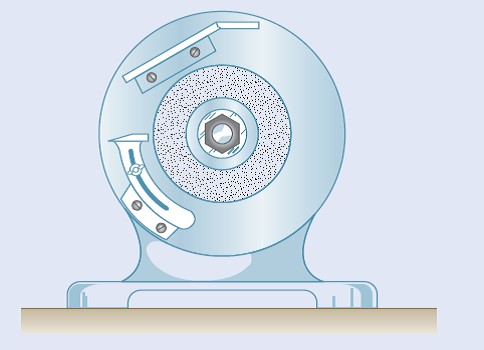
Elements Of Electromagnetics
7th Edition
ISBN: 9780190698614
Author: Sadiku, Matthew N. O.
Publisher: Oxford University Press
expand_more
expand_more
format_list_bulleted
Concept explainers
Question
A small grinding wheel is attached to the shaft of an electric motor that has a rated speed of 3600 rpm. When the power is turned off, the unit coasts to rest in 70 s. The grinding wheel and rotor have a combined weight of 6 lb and a combined radius of gyration of 2 in. Determine the average magnitude of the couple due to kinetic friction in the bearings of the motor.

Expert Solution
This question has been solved!
Explore an expertly crafted, step-by-step solution for a thorough understanding of key concepts.
This is a popular solution
Trending nowThis is a popular solution!
Step by stepSolved in 3 steps with 3 images

Knowledge Booster
Learn more about
Need a deep-dive on the concept behind this application? Look no further. Learn more about this topic, mechanical-engineering and related others by exploring similar questions and additional content below.Similar questions
- The system is at rest with the spring unstretched when theta = 0. the 5.3 kg uniform slender bar is then given a slight clockwise nudge. The value of b is 0.45 m. (a) if the bar comes to momentary rest when theta = 58, determine the spring constant k. (b) for the value k = 65 N/m, find the magnitude of the angular velocity of th ebar when theta = 38 degrees.arrow_forwardThe system is at rest with the spring unstretched when theta = 0. the 5.3 kg uniform slender bar is then given a slight clockwise nudge. The value of b is 0.45 m. (a) if the bar comes to momentary rest when the angle = 58, determine the spring constant k. (b) for the value k = 65 N/m, find the magnitude of the angular velocity of the bar when the angle = 38 degrees. a) k = 70.634 N/marrow_forwardThe slotted circular disk whose mass is 4.9 kg has a radius of gyration about O of 230 mm. The disk carries the four steel balls, each of mass 0.17 kg and located as shown, and rotates freely about a vertical axis through O with an angular speed of 164 rev/min. Each of the small balls is held in place by a latching device not shown. If the balls are released while the disk is rotating and come to rest relative to the disk at the outer ends of the slots, compute the new angular speed N of the disk. Also find the magnitude |AE| of the energy loss due to the impact of the balls with the ends of the slots. Neglect the diameter of the balls and discuss this approximation. 164 rev/min 145 mm 305 mmarrow_forward
- Consider the wheel shown below with radius R, mass m, and radius of gyration ko¹ The wheel rolls without slipping under the action of a clockwise torque M. At the instant shown the spring with spring constant ks is unstretched. Derive an expression for the velocity of the wheel center of mass G after the center of mass has moved a distance d. (Hint: Use rigid body work-energy principles. The work done to the system by the applied moment is McA0 and A0 can be related to the distace d by the no-slip condition.) Us G R M м, ко ////arrow_forwardA drum can rotate about a fixed-point O. The A block is attached to a cord wrapping around the drum. The mass of the drum is md = 100kg and the radius is r = 0.5 m. The radius of gyration of the drum about point O is ko=0.3 m. The mass of the block is mb= 20kg. The block is released from rest. The acceleration due to gravity is g=9.81 m/s2. (1) Calculate the mass moment of inertia of the drum about the point O, IO_______(kgm2) (two decimal places)arrow_forwardMotive power for the experimental 17.9-Mg bus comes from the energy stored in a rotating flywheel which it carries. The flywheel has a mass of 1380 kg and a radius of gyration of 560 mm and is brought up to a maximum speed of 3560 rev/min. If the bus starts from rest and acquires a speed of 60 km/h at the top of a hill 89 m above the starting position, compute the reduced speed N of the flywheel. Assume that 9 percent of the energy taken from the flywheel is lost. Neglect the rotational energy of the wheels of the bus. The 17.9-Mg mass includes the flywheel.arrow_forward
arrow_back_ios
arrow_forward_ios
Recommended textbooks for you
 Elements Of ElectromagneticsMechanical EngineeringISBN:9780190698614Author:Sadiku, Matthew N. O.Publisher:Oxford University Press
Elements Of ElectromagneticsMechanical EngineeringISBN:9780190698614Author:Sadiku, Matthew N. O.Publisher:Oxford University Press Mechanics of Materials (10th Edition)Mechanical EngineeringISBN:9780134319650Author:Russell C. HibbelerPublisher:PEARSON
Mechanics of Materials (10th Edition)Mechanical EngineeringISBN:9780134319650Author:Russell C. HibbelerPublisher:PEARSON Thermodynamics: An Engineering ApproachMechanical EngineeringISBN:9781259822674Author:Yunus A. Cengel Dr., Michael A. BolesPublisher:McGraw-Hill Education
Thermodynamics: An Engineering ApproachMechanical EngineeringISBN:9781259822674Author:Yunus A. Cengel Dr., Michael A. BolesPublisher:McGraw-Hill Education Control Systems EngineeringMechanical EngineeringISBN:9781118170519Author:Norman S. NisePublisher:WILEY
Control Systems EngineeringMechanical EngineeringISBN:9781118170519Author:Norman S. NisePublisher:WILEY Mechanics of Materials (MindTap Course List)Mechanical EngineeringISBN:9781337093347Author:Barry J. Goodno, James M. GerePublisher:Cengage Learning
Mechanics of Materials (MindTap Course List)Mechanical EngineeringISBN:9781337093347Author:Barry J. Goodno, James M. GerePublisher:Cengage Learning Engineering Mechanics: StaticsMechanical EngineeringISBN:9781118807330Author:James L. Meriam, L. G. Kraige, J. N. BoltonPublisher:WILEY
Engineering Mechanics: StaticsMechanical EngineeringISBN:9781118807330Author:James L. Meriam, L. G. Kraige, J. N. BoltonPublisher:WILEY

Elements Of Electromagnetics
Mechanical Engineering
ISBN:9780190698614
Author:Sadiku, Matthew N. O.
Publisher:Oxford University Press

Mechanics of Materials (10th Edition)
Mechanical Engineering
ISBN:9780134319650
Author:Russell C. Hibbeler
Publisher:PEARSON

Thermodynamics: An Engineering Approach
Mechanical Engineering
ISBN:9781259822674
Author:Yunus A. Cengel Dr., Michael A. Boles
Publisher:McGraw-Hill Education

Control Systems Engineering
Mechanical Engineering
ISBN:9781118170519
Author:Norman S. Nise
Publisher:WILEY

Mechanics of Materials (MindTap Course List)
Mechanical Engineering
ISBN:9781337093347
Author:Barry J. Goodno, James M. Gere
Publisher:Cengage Learning

Engineering Mechanics: Statics
Mechanical Engineering
ISBN:9781118807330
Author:James L. Meriam, L. G. Kraige, J. N. Bolton
Publisher:WILEY